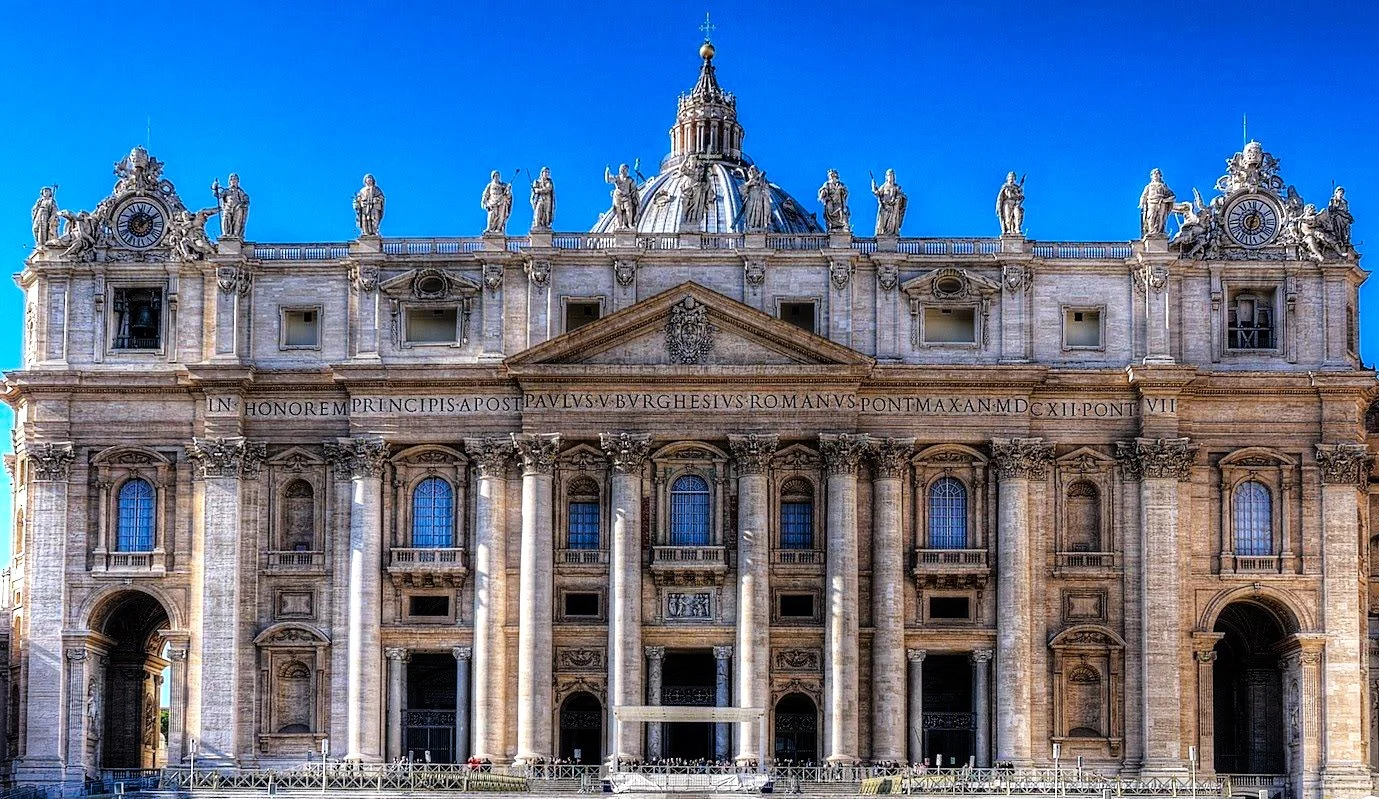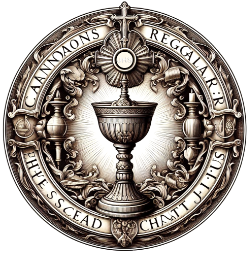
DECLARATION OF COMPLIANCE WITH THE
HOLY SEE OF ROME
Declaration ‘Dominus Jesus’ 6th Aug. 2000

Foundational Statement:
Declaration ‘Dominus Jesus’ - Holy See, 6th August 2000
The Holy See Declaration Dominus Jesus of the 6th of August 2000, which you may wish to consult online here, countersigned by Cardinals Joseph Ratzinger (late Pope Emeritus Benedict XVI) and Cardinal Tarcisio Bertone, and promulgated by His Holiness Pope Saint John Paul II, states the following on parts 16 and 17:
The Catholic faithful are required to profess that there is an historical continuity - rooted in the apostolic succession - between the Church founded by Christ and the Catholic Church: “This is the single Church of Christ... which our Saviour, after his resurrection, entrusted to Peter's pastoral care (cf. Jn 21:17), commissioning him and the other Apostles to extend and rule her (cf. Mt 28:18ff.), erected for all ages as 'the pillar and mainstay of the truth' (1 Tim 3:15). This Church, constituted and organized as a society in the present world, subsists in the Catholic Church.
(…) the Church of Christ, despite the divisions which exist among Christians, continues to exist fully only in the Catholic Church, and on the other hand, that “outside of her structure, many elements can be found of sanctification and truth”, that is, in those Churches and ecclesial communities which are not yet in full communion with the Catholic Church. But with respect to these, it needs to be stated that “they derive their efficacy from the very fullness of grace and truth entrusted to the Catholic Church”.
(…) Therefore, there exists a single Church of Christ, which subsists in the Catholic Church, governed by the Successor of Peter and by the Bishops in communion with him. The Churches(1) which, while not existing in perfect communion with the Catholic Church, remain united to her by means of the closest bonds, that is, by apostolic succession and a valid Eucharist, are true particular Churches. Therefore, the Church of Christ is present and operative also in these Churches(…).
(1) Of which the Old Catholic Church is one. The Canons Regular are an Old Catholic Church Community.
His Holiness, Pope Leo XIV

The Canons Regular of the Sacred Heart of Jesus’ Statement
The Canons Regular of the Sacred Heart of Jesus (Institute), a non-profit religious organisation incorporated in England under Registration No. 16585492, stands as a recognised community within the Old Catholic tradition. The Institute affirms its good standing in full accord with the requirements and stipulations outlined in the Declaration ‘Dominus Jesus’ of the 6th of August 2000, issued by the Holy See. Our legal framework and jurisdiction are detailed below:
Jurisdiction
The Canons Regular of the Sacred Heart of Jesus constitute an independent and autonomous ecclesial body incorporated in England & Wales as a non-profit Institute under Reg. No. 16585492 and are therefore neither subject to the jurisdiction of the Holy See, nor any other juridically constituted Church.
As such, the Canons Regular of the Sacred Heart of Jesus incardinate their own Clergy, and the admission of members (Clergy or brothers) depends solely on the vocational discernment carried out by the candidates in close confidence with the Institute. Our ordinands shall be ordained into Holy Orders by a duly appointed Bishop holder of Apostolic Succession in good standing.
We are governed by a consultative Chapter and an Executive Canon Superior General who was ordained and received presbyteral Holy Orders within Apostolic Succession in good standing (see below under title ‘Apostolic Succession’.
Notwithstanding its autonomy and independence, and in accordance with the Declaration above issued by the Holy See, we affirm our full communion with the One, Holy, Catholic and Apostolic Church of Christ.
Apostolic Succession
The Canons Regular of the Sacred Heart of Jesus’ Canon Superior General received Presbyteral Holy Orders in full and proper Apostolic Succession, going back to the original Early Church of Christ, through the following lines:
Succession from the Chaldean Catholic Church, fully traced back to Thoma Shlikha (Saint Thomas) (c. 33-c. 77) and Tulmay (St. Bartholomew the Apostle) (c. 33).
Succession from the Syrian-Orthodox Patriarchate of Antioch, fully traced back to St. Peter the Apostle, 37-67 and St. Evodius, 67-68.
The Coptic Orthodox Succession, fully traced back to Saint Mark the Evangelist, 61 and Inianos, 64.
Succession from the Russian Orthodox Church, fully traced back to Peter the Apostle (ca. 37–ca. 53) and Evodius (ca. 53–ca. 69).
Succession from the Melkite-Greek Patriarchate of Antioch and all East, fully traced back to Peter the Apostle (ca. 37–ca. 53), Evodius (ca. 53–ca. 69) and Ignatius (ca. 70–ca. 107).
Bishop Duarte Costa Succession – Roman Catholic Succession, fully traced back to St. Peter the Apostle — to 64 A.D., St. Linus — 67 to 76, St. Anacletus — 76 to 91, St. Clement I — 91 to 101 and St. Evaristus — 100 to 109.
Succession from the Anglican Communion, fully traced back to St. Peter the Apostle and St Linus 67 to 76.
Succession from the Liberal Catholic Church, fully traced back to St. Peter the Apostle — to 64 A.D., St. Linus — 67 to 76 and St. Anacletus — 76 to 91.
Succession from the Ancient Catholic Church, fully traced back to St. Peter the Apostle — to 64 A.D., St. Linus — 67 to 76 and St. Anacletus — 76 to 91.
Succession from the Young Rite, fully traced back to St. Peter the Apostle — to 64 A.D., St. Linus — 67 to 76 and St. Anacletus — 76 to 91.
Eucharist
At the heart of the Canons and Brothers Regular stands the profound mystery of the Holy Eucharist, where Christ is truly, wholly, and substantially present - Body, Blood, Soul, and Divinity -. This sacred truth, instituted by Christ Himself at the Last Supper, is the fulfilment of His eternal promise: “This is My Body… This is My Blood” (Matthew 26:26-28). In the Eucharist, He remains with us, not as a mere symbol, but as the living God who nourishes and sustains His people.
Through the miracle of transubstantiation, the bread and wine, consecrated by the priest, become the very substance of Christ, though their outward appearance remains unchanged. This divine mystery, affirmed by Sacred Scripture and upheld by the Church since its earliest days, draws us into intimate communion with our Lord, who gives Himself entirely for our salvation.
Sacraments
Therefore, in fidelity to our Apostolic Succession and the enduring tenets of the Catholic faith, we solemnly profess the Seven Sacraments. These sacred mysteries, beginning with Baptism and embraced through the full sacramental life, mark our adherence to the Church and our full participation in communion with God—the Father, the Son, and the Holy Spirit.
Profession of Faith’s Core Tenets
The Catholic Creed - particularly the Nicene-Constantinopolitan Creed approved at the Ecumenical Council of Constantinople in 381 AD - serves as a foundational statement of Christian belief, encapsulating the Canons and Brothers Regular’s core tenets of the faith. It is the only authoritative ecumenical statement of the Christian faith accepted by the Catholic Church (with the addition of the Filioque), the Eastern Orthodox Church, Oriental Orthodoxy, the Church of the East, and much of Protestantism, including the Anglican communion.


